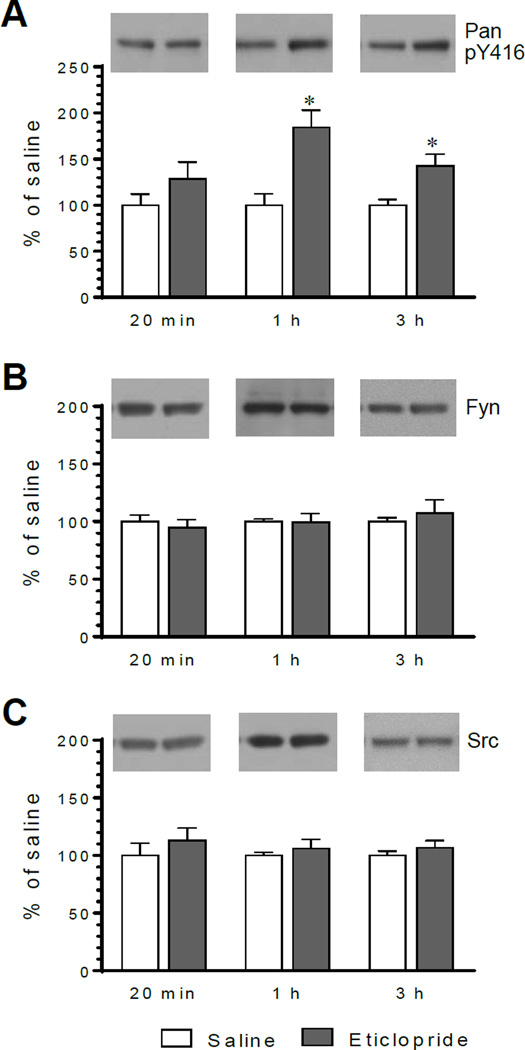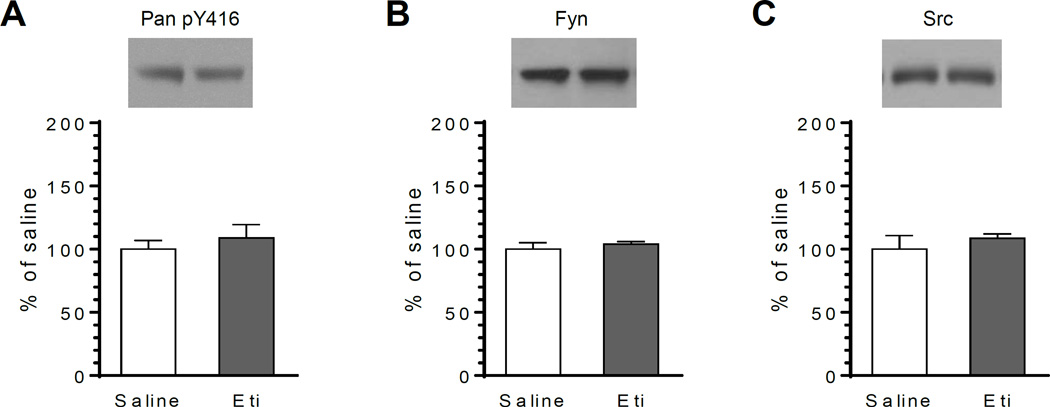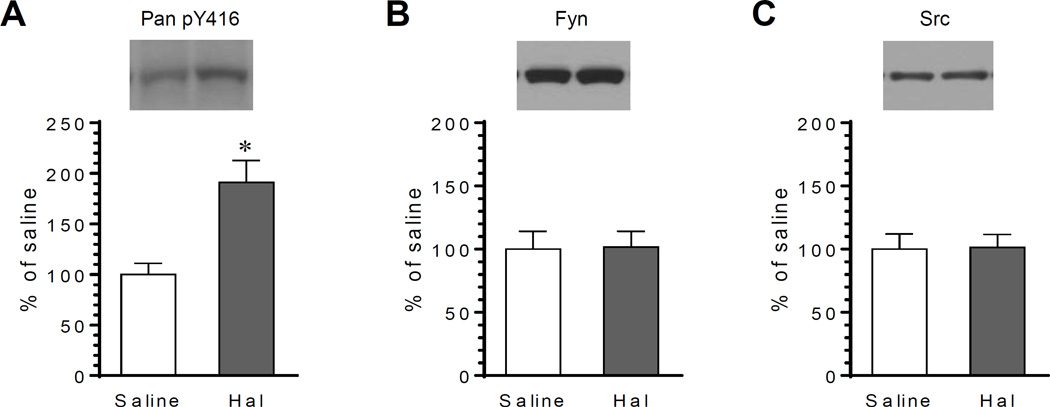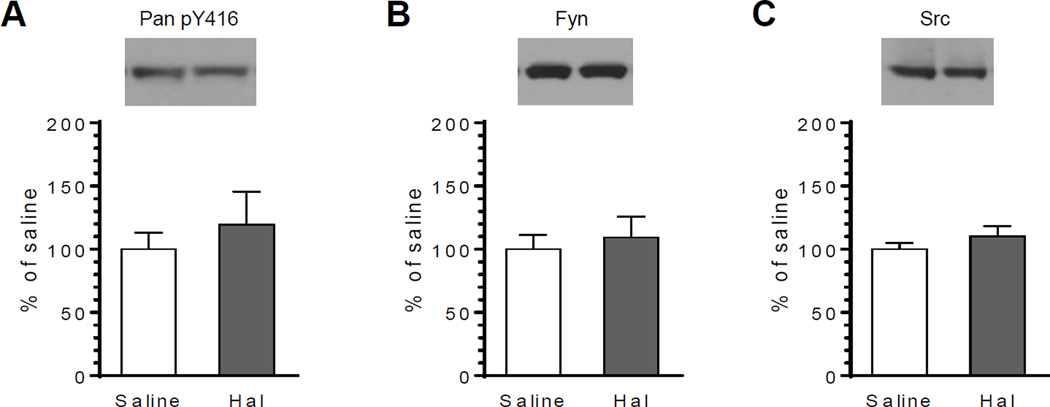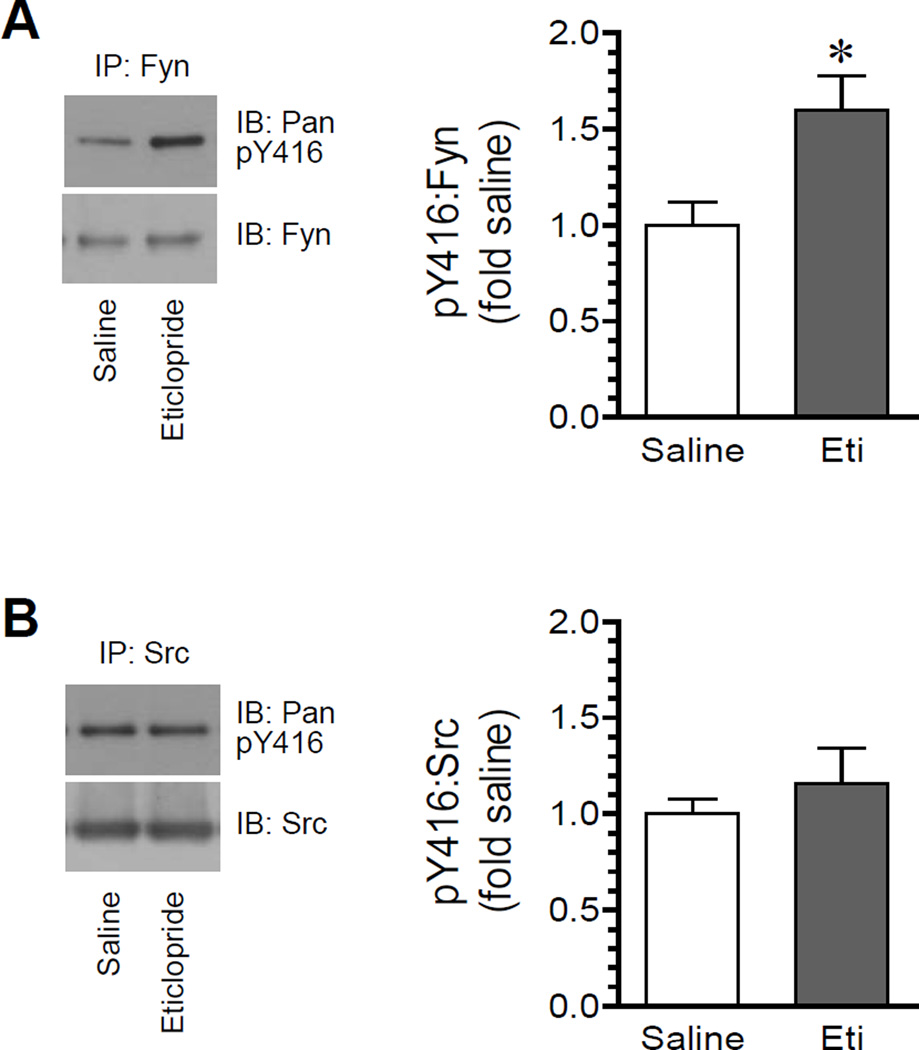Abstract
Several Src family kinase (SFK) members are expressed in the mammalian brain and serve as key kinases in the regulation of a variety of cellular and synaptic events. These SFKs may be subject to the modulation by dopamine, although this topic has been investigated incompletely. In this study, we explored whether dopamine D2 receptors (D2R) regulate SFKs in adult rat brains in vivo. We investigated the role of D2Rs in two forebrain areas, the medial prefrontal cortex (mPFC) and hippocampus, since dopamine plays a pivotal role in regulating activity of mPFC and hippocampal neurons and D2Rs are expressed in these regions. We found that a systemic injection of a D2R selective antagonist eticlopride elevated phosphorylation of SFKs at a conserved autophosphorylation site, an event correlated with activation of SFKs, in the mPFC. Similarly, antagonism of D2Rs by haloperidol increased SFK phosphorylation. In contrast, eticlopride and haloperidol did not alter SFK phosphorylation in the hippocampus. The effect of eticlopride was time-dependent and relatively delayed. Among two common SFK members enriched at synaptic sites, eticlopride selectively altered phosphorylation of Fyn but not Src. Our data suggest that D2Rs exert an inhibitory effect on the activity-related phosphorylation of Fyn in the mPFC under normal conditions.
Keywords: non-receptor tyrosine kinase, Fyn, Src, eticlopride, haloperidol, prefrontal cortex, hippocampus
Introduction
Non-receptor tyrosine kinases are an important subgroup of protein kinases involved in the regulation of synaptic transmission and plasticity in mammalian brains (Neet and Hunter, 1996) and are linked to the pathogenesis of a verity of brain diseases (Schenone et al., 2011). Fyn, i.e., FynB isoform, and Src are two typical members of the Src family kinase (SFK), a subfamily of non-receptor tyrosine kinases (Neet and Hunter, 1996), and are particularly enriched at synaptic sites. Both Fyn and Src are able to phosphorylate a discrete set of substrates within the synaptic structure and thereby phosphorylation-dependently modulate the efficacy and strength of synaptic signaling (Kalia et al., 2004; Ohnishi et al., 2011; Schenone et al., 2011). SFKs are also regulated by a phosphorylation-mediated mechanism as their activity is enhanced by autophosphorylation at a conserved residue, tyrosine 416 (Y416) (Roskoski, 2005; Okada, 2012). Noticeably, Y416 phosphorylation is a sensitive step subjected to the vigorous regulation by changing cellular and synaptic input.
The medial prefrontal cortex (mPFC) is a forebrain structure implicated in motor and cognitive functions and in the pathogenesis and symptomatology of various neuropsychiatric and neurological disorders (Giustino and Maren, 2015; Morici et al., 2015). This region, as a mesocortical dopamine responsive site, is notable with a high level of expression of dopamine receptors. In addition to dopamine D1 receptors, dopamine D2 receptors (D2R) are abundant and reside on pyramidal neurons, local interneurons, and presynaptic terminals (Vincent et al., 1993; Gaspar et al., 1995; Sesack et al., 1995). As Gαi/o-coupled receptors, D2Rs inhibit adenylyl cyclase and thus reduce cAMP formation and protein kinase A (PKA) activation (Neve et al., 2004). Similarly, D2Rs inhibited the excitability of prefrontal cortical projection neurons (Trantham-Davidson et al., 2004; Tseng and O’Donnell, 2004). However, to date, whether D2Rs are linked to SFKs in mPFC neurons is unclear. Given that Fyn and Src are enriched in the mPFC (Sorge et al., 1985; Ohnuma et al., 2003; Hu et al., 2010) and that the cAMP-PKA pathway is positively linked to SFKs (Schmitt and Stork, 2002; Yang et al., 2011; Yeo et al., 2011), it is intriguing to investigate whether D2Rs are involved in the modulation of SFK activity in the mPFC.
In this study, we carried out experiments to define the role of D2Rs in the regulation of phosphorylation of SFKs in the mPFC. We first tested the effect of the D2R selective antagonist eticlopride on SFK phosphorylation at Y416 in the mPFC. Since SFKs are actively involved in the regulation of synaptic plasticity related to learning and memory in hippocampal neurons (MacDonald et al., 2006), we tested the effect of eticlopride on SFK phosphorylation in the hippocampus. We then examined the effect of another D2R antagonist haloperidol on SFK phosphorylation in both the mPFC and hippocampus. Finally, we investigated effects of eticlopride on Y416 phosphorylation of immunopurified Fyn and Src from the mPFC.
Materials and Methods
Animals and drug treatment
In this study, we used adult male Wistar rats weighing 250–340 g (Charles River, New York, NY). Animals were housed in pairs and the animal room was on a 12-h/12-h light/dark cycle and was controlled at a constant temperature of 23°C and humidity of 50 ± 10% with food and water available ad libitum. All animal use and procedures were in strict accordance with the US National Institutes of Health Guide for the Care and Use of Laboratory Animals and were approved by the Institutional Animal Care and Use Committee.
Rats were treated with a single intraperitoneal (i.p.) injection of a drug in a volume of 1 ml/kg. Age-matched rats were injected with saline (1 ml/kg) and served as a control. The D2R antagonist eticlopride was injected at a dose of 0.5 mg/kg which was calculated as the salt. The dose of 0.5 mg/kg was chosen because a systemic injection of eticlopride at this dose produced behavioral changes as a result of blockade of D2Rs (LaHoste and Marshall, 1990; Wang and McGinty, 1995). Another D2R antagonist haloperidol was injected at a dose of 1 mg/kg calculated as the salt. This dose was chosen because haloperidol at this dose (1 h prior to brain tissue collection) increased tyrosine phosphorylation of several proteins in the mouse striatum (Hattori et al., 2006).
Western blot
Rats were sacrificed by decapitation after anesthetized with sodium pentobarbital (65 mg/kg, i.p.). Removed brains were cut into coronal slices. The mPFC and hippocampus were dissected and were homogenized in a radioimmunoprecipitation assay (RIPA) buffer containing 20 mM Tris-HCl, pH 7.5, 150 mM NaCl, 1 mM Na2EDTA, 1 mM EGTA, 1% NP-40, 1% sodium deoxycholate, 2.5 mM sodium pyrophosphate, 1 mM β-glycerophosphate, 1 mM Na3VO4, and 1µg/ml leupeptin (Cell Signaling Technology, Danvers, MA). The sample was centrifuged at 800 g (10 min, 4°C). The supernatant was collected for immunoblot analysis. Protein concentrations were determined. Samples were stored at −80°C until use.
Western blots were performed as described previously (Jin et al., 2013). Briefly, proteins were separated on SDS NuPAGE Novex 4-12% gels (Invitrogen, Carlsbad, CA) and were transferred to polyvinylidene fluoride membranes. After blocked, washed, and incubated in a primary antibody overnight at 4°C, membranes were incubated in a secondary antibody. Proteins were visualized by an enhanced chemiluminescence reagent (GE Healthcare Life Sciences, Piscataway, NJ) and were measured using ImageJ analysis software. Values of optical density were normalized to a loading control (actin).
Immunoprecipitation
This was carried out as described previously (Mao and Wang, 2016b). The mPFC was homogenized in a RIPA lysis buffer. After centrifuged at 800 g (10 min, 4°C), the supernatant was used for immunoprecipitation. Proteins were incubated in a buffer containing a mouse antibody against Src (2 µg) or Fyn (3 µg). The protein complex was precipitated with 50% protein A & G agarose/sepharose bead slurry (GE Healthcare). Precipitated proteins were resolved on SDS-PAGE with a rabbit antibody against Src, Fyn, or phospho-Src family at Y416 (pan pY416).
Antibodies and pharmacological agents
Primary antibodies used in this study include rabbit polyclonal antibodies against Src (Cell Signaling), Fyn (Santa Cruz Biotechnology, Santa Cruz, CA), or β-actin (Sigma-Aldrich, St. Louis, MO), or mouse antibodies against Src (Cell Signaling) or Fyn (Santa Cruz). The rabbit antibody against pan pY416 (Cell Signaling) was used which reacts with the Src family members when phosphorylated at the conserved activation residue: Y416 (chicken Src), Y419 (rat Src), and Y420 (rat Fyn). Pharmacological agents include s-(-)-eticlopride hydrochloride (Sigma) and haloperidol (Sigma). All agents were freshly prepared at the day of experiments. Eticlopride was dissolved in physiological saline. Haloperidol was dissolved as described previously (Usiello et al., 2000).
Statistics
Data were statistically analyzed and are presented as means ± SEM. We used a one-way analysis of variance followed by a Bonferroni (Dunn) comparison of groups using least squares- adjusted means or a two-tailed unpaired Student's t-test to analyze data. Probability levels of < 0.05 were considered statistically significant.
Results
Eticlopride increases SFK Y416 phosphorylation in the mPFC
We first investigated whether pharmacological blockade of D2Rs has any impact on SFK activation, i.e., SFK phosphorylation at a conserved activation site (Y416). To this end, we administered the D2R blocker eticlopride to rats at a single effective dose (0.5 mg/kg, i.p.). We then sacrificed rats at different time points (20 min, 1 h, and 3 h after eticlopride injection) to detect changes in Y416 phosphorylation in the mPFC using immunoblots. At an early time point (20 min), eticlopride did not alter Y416 phosphorylation in the mPFC. As shown in Fig. 1A, pY416 levels remained stable in eticlopride-treated rats compared to saline-treated control rats. However, at 1 h, eticlopride induced a significant increase in pY416 signals. At a later time point (3 h), the eticlopride-induced increase in pY416 levels was still seen. At all time points surveyed, a total amount of Fyn proteins in eticlopride-treated rats was not different from that in saline rats (Fig. 1B). Similarly, total Src protein levels were not changed following eticlopride administration at three time points (Fig. 1C). These data indicate that eticlopride increases SFK phosphorylation in the mPFC at a defined time window after administration of a D2R blocker.
Figure 1. Eticlopride-induced elevation of Y416 phosphorylation in the rat mPFC.
(A) Effects of eticlopride on Y416 phosphorylation in the mPFC. (B and C) Effects of eticlopride on Fyn (B) and Src (C) expression in the mPFC. Representative immunoblots are shown above the quantified data. Note that eticlopride induced a time-dependent increase in Y416- phosphorylated protein levels. Rats were given a single i.p. dose of saline or eticlopride at 0.5 mg/kg and were sacrificed at different time points (20 min, 1 h, and 3 h) after drug injection for immunoblot analysis. Data are presented as means ± SEM (n = 3–8 per group). *P < 0.05 versus saline at the same time point.
Eticlopride has no effect on SFK Y416 phosphorylation in the hippocampus
Like the mPFC, the hippocampus is an important brain region implicated in normal learning and memory and is linked to the pathogenesis of various cognitive and neuropsychiatric disorders (Koob and Volkow, 2010). Given that D2Rs are expressed in the hippocampus (Gangarossa et al., 2012), we investigated the effect of eticlopride on SFK phosphorylation in this region. An i.p. injection of eticlopride at 0.5 mg/kg (1 h prior to tissue collection) showed a minimal influence over Y416 phosphorylation in the hippocampus (Fig. 2A). Similarly, eticlopride did not alter total Fyn and Src protein levels (Fig. 2B and 2C). Thus, eticlopride, while it increased Y416 phosphorylation in the mPFC, is ineffective in inducing changes in Y416 phosphorylation in the hippocampus.
Figure 2. Effects of eticlopride on Y416 phosphorylation in the rat hippocampus.
(A) Effects of eticlopride on Y416 phosphorylation in the hippocampus. (B and C) Effects of eticlopride on Fyn (B) and Src (C) expression in the hippocampus. Representative immunoblots are shown above the quantified data. Rats were given a single i.p. dose of saline or eticlopride (Eti) at 0.5 mg/kg and were sacrificed 1 h after drug injection for immunoblot analysis. Data are presented as means ± SEM (n = 4 per group).
Haloperidol increases SFK Y416 phosphorylation in the mPFC
We next investigated the effect of a typical antipsychotic agent haloperidol that exhibits high affinity antagonism of D2Rs. Rats were treated with a single dose of haloperidol (1 mg/kg, i.p.) and were sacrificed 1 h after drug injection. The mPFC was dissected to analyze changes in SFK Y416 phosphorylation. It was found that haloperidol markedly altered SFK phosphorylation. As shown in Fig. 3A, a significant increase in pY416 protein levels was seen in haloperidol-treated rats relative to saline-treated rats. Total Fyn and Src protein levels remained unchanged in response to haloperidol (Fig. 3B and 3C). These data demonstrate that haloperidol, like eticlopride, upregulates SFK Y416 phosphorylation in mPFC neurons.
Figure 3. Haloperidol-induced elevation of Y416 phosphorylation in the rat mPFC.
(A) Effects of haloperidol on Y416 phosphorylation in the mPFC. (B and C) Effects of haloperidol on Fyn (B) and Src (C) expression in the mPFC. Representative immunoblots are shown above the quantified data. Note that haloperidol induced a significant increase in Y416-phosphorylated protein levels. Rats were given a single i.p. dose of saline or haloperidol (Hal) at 1 mg/kg and were sacrificed 1 h after drug injection for immunoblot analysis. Data are presented as means ± SEM (n = 4 per group). *P < 0.05 versus saline.
The effect of haloperidol was also tested in the hippocampus of the same animals. No significant change in Y416 phosphorylation was seen following haloperidol administration (Fig. 4A). Fyn and Src protein levels remained stable in response to haloperidol (Fig. 4B and 4C). Thus, haloperidol has no significant impact on hippocampal SFK Y416 phosphorylation.
Figure 4. Effects of haloperidol on Y416 phosphorylation in the rat hippocampus.
(A) Effects of haloperidol on Y416 phosphorylation in the hippocampus. (B and C) Effects of haloperidol on Fyn (B) and Src (C) expression in the hippocampus. Representative immunoblots are shown above the quantified data. Rats were given a single i.p. dose of saline or haloperidol (Hal) at 1 mg/kg and were sacrificed 1 h after drug injection for immunoblot analysis. Data are presented as means ± SEM (n = 4 per group).
Eticlopride selectively phosphorylates Fyn
We next compared Fyn and Src for their phosphorylation responses to eticlopride. To achieve this, Fyn and Src proteins were separated from mPFC lysates by immunoprecipitation. Immunoprecipitated Fyn and Src proteins were then assayed for changes in Y416 phosphorylation using immunoblots. A single dose of eticlopride (0.5 mg/kg, 1 h) was effective in enhancing Fyn phosphorylation. As shown in Fig. 5A, pY416 signals in immunoprecipitated Fyn were increased in eticlopride-treated rats relative to saline-treated rats. In contrast, pY416 signals in immunoprecipitated Src were not altered following eticlopride administration (Fig. 5B). Thus, D2Rs seem to target Fyn rather than Src.
Figure 5. Eticlopride-induced elevation of Y416 phosphorylation in immunoprecipitated Fyn proteins from the rat mPFC.
(A) Effects of eticlopride on phosphorylation of immunopurified Fyn. (B) Effects of eticlopride on phosphorylation of immunopurified Src. Note that eticlopride selectively increased Fyn phosphorylation. Representative immunoblots are shown left to the quantified data. Rats were given a single dose of eticlopride (Eti) at 0.5 mg/kg (i.p.) and were sacrificed 1 h after drug injection for immunoprecipitation (IP) of Fyn and Src, followed by immunoblot (IB) analysis of Fyn and Src phosphorylation. Data are presented as means ± SEM (n = 5 per group). *P < 0.05 versus saline.
Discussion
We conducted a series of pharmacological studies to define the role of D2Rs in the regulation of SFKs in the mPFC and hippocampus in vivo. We found that blockade of D2Rs with a selective antagonist eticlopride elevated SFK phosphorylation at a conserved activation site. Another D2R antagonist haloperidol also produced the same effect. In contrast, the two antagonists did not alter SFK phosphorylation in the hippocampus. All drug treatments did not alter levels of total Fyn and Src proteins in the two brain regions. The eticlopride-induced elevation of SFK phosphorylation primarily occurred in Fyn rather than Src. These data reveal an inhibitory connection of D2Rs with Fyn in mPFC neurons.
Early studies have demonstrated that SFKs are regulated in tyrosine phosphorylation by dopamine signaling. For instance, dopamine D1 receptor agonists stimulated SFK Y416 phosphorylation in the striatum (Pascoli et al., 2011; Mao and Wang, 2015), establishing a role of D1 receptors in upregulating phosphorylation of SFKs. In addition to D1 receptors, D2Rs are engaged in the regulation of SFK phosphorylation. However, as opposed to D1 receptors, D2Rs inhibit SFK phosphorylation. As can be seen from this study, blockade of D2Rs by eticlopride or haloperidol elevated SFK phosphorylation in the mPFC, which is consistent with findings in the striatum (Hattori et al., 2006; Mao and Wang, 2016b). Of note, the regulatory role of D2Rs seems to specifically target Fyn since the receptors regulate Fyn but not Src phosphorylation in the mPFC. Unlike the mPFC and striatum, the hippocampal region seems to be an insensitive central site where neither eticlopride nor haloperidol produced a significant change in SFK phosphorylation. The reason for this insensitivity is unclear. It underscores the complex of mechanisms controlling SFY phosphorylation in this region.
Regarding the post-receptor signaling pathway linking D2Rs to Fyn, D2Rs as Gαi/o- coupled receptors are known to inhibit the cAMP production and subsequent activation of PKA (Neve et al., 2004). It has been found that PKA can phosphorylate a serine residue on Fyn (S21) and Src (S17) to allow Y416 autophosphorylation (Schmitt and Stork, 2002; Yeo et al., 2011). Similarly, a PKA activator forskolin activated Fyn in mouse spinal dorsal horn neurons (Yang et al., 2011). Thus, cAMP and PKA could form a signaling pathway positively linked to the phosphorylation of Fyn. However, it should be pointed out whether this cAMP-PKA pathway links D2Rs to Fyn is unclear. Future studies will have to elucidate the role of the cAMP-PKA pathway in mediating the D2R inhibition of Fyn phosphorylation.
Fyn and Src are synapse-enriched kinases and are believed to be vigorously involved in the regulation of local substrates to control synaptic transmission and plasticity (Kalia et al., 2004; Ohnishi et al., 2011; Schenone et al., 2011). In fact, it has been well established that Fyn or Src regulates ionotropic glutamate receptors to modulate the strength and efficacy of synaptic transmission (Kalia et al., 2004; Ohnishi et al., 2011; Groveman et al., 2012; Trepanier et al., 2012). In addition to ionotropic glutamate receptors, metabotropic glutamate receptors (mGluR) are also subject to tyrosine phosphorylation (Mao and Wang, 2016a; Mao et al., 2011). For instance, mGluR5 is among tyrosine-phosphorylated proteins in the rat cortex, striatum and hippocampus (Orlando et al., 2002; Mao and Wang, 2016b) and the mouse forebrain (Giuffrida et al., 2005). Given the fact that the prefrontal cortex is enriched with SFKs (Sorge et al., 1985; Ohnuma et al., 2003; Hu et al., 2010) and glutamate receptors including mGluR5 (Muly et al., 2003) in addition to D2Rs (Vincent et al., 1993; Gaspar et al., 1995; Sesack et al., 1995), it will be intriguing to investigate whether D2Rs regulate tyrosine phosphorylation of mGluR5 or other glutamate receptors in mPFC neurons in the future.
Among nine SFK members so far identified, five are expressed in the mammalian brain, including Src, Fyn, Yes, Lyn, and Lck (Omri et al., 1996; Kalia et al., 2004; Bongiorno-Borbone et al., 2005). We have studied the two SFK members (Fyn and Src) in this study. While we have found that Fyn rather than Src is responsive to D2R signals, other neuron-enriched SFK members (Yes, Lyn and Lck) which are all present in the synaptic location (Kalia and Salter, 2003) are unclear for their connections to D2Rs. Future studies will elucidate the participation of these members in the D2R-associated signaling transduction.
Acknowledgments
This work was supported by NIH grants R01DA10355 (JQW) and R01MH61469 (JQW). Authors wish to thank Drs. Bing Xue and Elton Chen for their technical assistance.
Footnotes
Conflict of interest
The authors declare that they have no conflict of interest.
References
- Bongiorno-Borbone L, Kadare G, Benfenati F, Girault JA. FAK and PYK2 interact with SAP90/PSD-95-associated protein-3. Biochem Biophys Res Commun. 2005;337:641–646. doi: 10.1016/j.bbrc.2005.09.099. [DOI] [PubMed] [Google Scholar]
- Kalia LV, Gingrich JR, Salter MW. Src in synaptic transmission and plasticity. Oncogene. 2004;23:8007–8016. doi: 10.1038/sj.onc.1208158. [DOI] [PubMed] [Google Scholar]
- Kalia LV, Salter MW. Interactions between Src family protein tyrosine kinases and PSD-95. Neuropharmacology. 2003;45:720–728. doi: 10.1016/s0028-3908(03)00313-7. [DOI] [PubMed] [Google Scholar]
- Gangarossa G, Longueville S, Bundel DD, Perroy J, Herve D, Girault JA, Valjent E. Characterization of dopamine D1 and D2 receptor-expressing neurons in the mouse hippocampus. Hippocampus. 2012;22:2199–2207. doi: 10.1002/hipo.22044. [DOI] [PubMed] [Google Scholar]
- Gaspar P, Bloch B, Le Moine C. D1 and D2 receptor gene expression in the rat frontal cortex: cellular localization in different classes of efferent neurons. Eur J Neurosci. 1995;7:1050–1063. doi: 10.1111/j.1460-9568.1995.tb01092.x. [DOI] [PubMed] [Google Scholar]
- Giuffrida R, Musumeci S, D’Antoni S, Bonaccorso CM, Giuffrida-Stella AM, Oostra BA, Catania MV. A reduced number of metabotropic glutamate subtype 5 receptors are associated with constitutive Homer proteins in a mouse model of Fragile X Syndrome. J Neurosci. 2005;25:8908–8916. doi: 10.1523/JNEUROSCI.0932-05.2005. [DOI] [PMC free article] [PubMed] [Google Scholar]
- Giustino TF, Maren S. The role of the medial prefrontal cortex in the conditioning and extinction of fear. Front Behav Neurosci. 2015;9:298. doi: 10.3389/fnbeh.2015.00298. [DOI] [PMC free article] [PubMed] [Google Scholar]
- Groveman BR, Feng S, Fang XQ, Plueger M, Lin SX, Bienkiewicz EA, Yu X. The regulation of N-methyl-D-aspartate receptors by Src kinase. FEBS J. 2012;279:20–28. doi: 10.1111/j.1742-4658.2011.08413.x. [DOI] [PubMed] [Google Scholar]
- Hattori K, Uchino S, Isosaka T, Maekawa M, Iyo M, Sato T, Kohsaka S, Yagi T, Yuasa S. Fyn is required for haloperiodol-induced catalepsy in mice. J Biol Chem. 2006;281:7129–7135. doi: 10.1074/jbc.M511608200. [DOI] [PubMed] [Google Scholar]
- Hu JL, Liu G, Li YC, Gao WJ, Huang YQ. Dopamine D1 receptor-mediated NMDA receptor insertion depends on Fyn but not Src kinase pathway in prefrontal cortical neurons. Mol Brain. 2010;3:20. doi: 10.1186/1756-6606-3-20. [DOI] [PMC free article] [PubMed] [Google Scholar]
- Jin DZ, Guo ML, Xue B, Fibuch EE, Choe ES, Mao LM, Wang JQ. Phosphorylation and feedback regulation of metabotropic glutamate receptor 1 by calcium/calmodulin-dependent protein kinase II. J Neurosci. 2013;33:3402–3412. doi: 10.1523/JNEUROSCI.3192-12.2013. [DOI] [PMC free article] [PubMed] [Google Scholar]
- Kalia LV, Gingrich JR, Salter MW. Src in synaptic transmission and plasticity. Oncogene. 2004;23:8007–8016. doi: 10.1038/sj.onc.1208158. [DOI] [PubMed] [Google Scholar]
- Kalia LV, Salter MW. Interactions between Src family protein tyrosine kinases and PSD-95. Neuropharmacology. 2003;45:720–728. doi: 10.1016/s0028-3908(03)00313-7. [DOI] [PubMed] [Google Scholar]
- Koob GF, Volkow ND. Neurocircuitry of addiction. Neuropsychopharmacology. 2010;35:217–238. doi: 10.1038/npp.2009.110. [DOI] [PMC free article] [PubMed] [Google Scholar]
- LaHoste GJ, Marshall JF. Nigral D1 and striatal D2 receptors mediate the behavioral effects of dopamine agonists. Behav Brain Res. 1990;38:233–242. doi: 10.1016/0166-4328(90)90178-h. [DOI] [PubMed] [Google Scholar]
- Liu XY, Mao LM, Zhang GC, Papasian CJ, Fibuch EE, Lan HX, Zhou HF, Xu M, Wang JQ. Activity-dependent modulation of limbic dopamine D3 receptors by CaMKII. Neuron. 2009;61:425–438. doi: 10.1016/j.neuron.2008.12.015. [DOI] [PMC free article] [PubMed] [Google Scholar]
- MacDonald JF, Jackson MF, Beazely MA. Hippocampal long-term synaptic plasticity and signal amplification of NMDA receptors. Crit Rev Neurobiol. 2006;18:71–84. doi: 10.1615/critrevneurobiol.v18.i1-2.80. [DOI] [PubMed] [Google Scholar]
- Mao LM, Guo ML, Jin DZ, Fibuch EE, Choe ES, Wang JQ. Post-translational modification biology of glutamate receptors and drug addiction. Front Neuroanat. 2011;5 doi: 10.3389/fnana.2011.00019. article19. [DOI] [PMC free article] [PubMed] [Google Scholar]
- Mao LM, Wang JQ. Dopaminergic and cholinergic regulation of Fyn tyrosine kinase phosphorylation in the rat striatum in vivo. Neuropharmacology. 2015;99:491–499. doi: 10.1016/j.neuropharm.2015.08.017. [DOI] [PMC free article] [PubMed] [Google Scholar]
- Mao LM, Wang JQ. Tyrosine phosphorylation of glutamate receptors by non-receptor tyrosine kinases: roles in depression-like behavior. Neurotransmitter. 2016a;3:e1118. [PMC free article] [PubMed] [Google Scholar]
- Mao LM, Wang JQ. Dopamine D2 receptors are involved in the regulation of Fyn and mGluR5 phosphorylation in the rat striatum in vivo. J Neurosci Res. 2016b;94:329–338. doi: 10.1002/jnr.23713. [DOI] [PMC free article] [PubMed] [Google Scholar]
- Morici JF, Bekinschtein P, Weisstaub NV. Medial prefrontal cortex in recognition memory in rodents. Behav Brain Res. 2015;292:241–251. doi: 10.1016/j.bbr.2015.06.030. [DOI] [PubMed] [Google Scholar]
- Muly EC, Maddox M, Smith Y. Distribution of mGluR1alpha and mGluR5 immunolabeling in primate prefrontal cortex. J Comp Neurol. 2003;467:521–535. doi: 10.1002/cne.10937. [DOI] [PubMed] [Google Scholar]
- Neet K, Hunter T. Vertebrate non-receptor protein-tyrosine kinase families. Genes Cell. 1996;1:147–169. doi: 10.1046/j.1365-2443.1996.d01-234.x. [DOI] [PubMed] [Google Scholar]
- Neve KA, Seamans JK, Trantham-Davidson H. Dopamine receptor signaling. J Recept Signal Transduct Res. 2004;24:165–205. doi: 10.1081/rrs-200029981. [DOI] [PubMed] [Google Scholar]
- Ohnishi H, Murata Y, Okazawa H, Matozaki T. Src family kinases: modulators of neurotransmitter receptor function and behavior. Trends Neurosci. 2011;34:629–637. doi: 10.1016/j.tins.2011.09.005. [DOI] [PubMed] [Google Scholar]
- Ohnuma T, Kato H, Arai H, McKenna PJ, Emson PC. Expression of Fyn, a non-receptor tyrosine kinase in prefrontal cortex from patients with schizophrenia and its correlation with clinical onset. Mol Brain Res. 2003;112:90–94. doi: 10.1016/s0169-328x(03)00051-2. [DOI] [PubMed] [Google Scholar]
- Okada M. Regulation of the Src family kinase by Csk. Int J Biol Sci. 2012;8:1385–1397. doi: 10.7150/ijbs.5141. [DOI] [PMC free article] [PubMed] [Google Scholar]
- Omri B, Crisanti P, Marty MC, Alliot F, Fagard R, Molina T, Pessac B. The Lck tyrosine kinase is expressed in brain neurons. J Neurochem. 1996;67:1360–1364. doi: 10.1046/j.1471-4159.1996.67041360.x. [DOI] [PubMed] [Google Scholar]
- Orlando LR, Dunah AW, Standaert DG, Young AB. Tyrosine phosphorylation of the metabotropic glutamate receptor mGluR5 in striatal neurons. Neuropharmacology. 2002;43:161–173. doi: 10.1016/s0028-3908(02)00113-2. [DOI] [PubMed] [Google Scholar]
- Pascoli V, Besnard A, Herve D, Pages C, Heck N, Girault JA, Caboche J, Vanhoutte P. Cyclic adenosine monophosphate-independent tyrosine phosphorylation of NR2B mediates cocaine-induced extracellular signal-regulated kinase activation. Biol Psychiatry. 2011;69:218–227. doi: 10.1016/j.biopsych.2010.08.031. [DOI] [PubMed] [Google Scholar]
- Roskoski R., Jr Src kinase regulation by phosphorylation and dephosphorylation. Biochem Biophys Res Commun. 2005;331:1–14. doi: 10.1016/j.bbrc.2005.03.012. [DOI] [PubMed] [Google Scholar]
- Schenone S, Brullo C, Musumeci F, Biava M, Falchi F, Botta M. Fyn kinase in brain diseases and cancer: the search for inhibitors. Curr Med Chem. 2011;18:2921–2942. doi: 10.2174/092986711796150531. [DOI] [PubMed] [Google Scholar]
- Schmitt JM, Stork PJ. PKA phosphorylation of Src mediates cAMP’s inhibition of cell growth via Rap1. Mol Cell. 2002;9:85–94. doi: 10.1016/s1097-2765(01)00432-4. [DOI] [PubMed] [Google Scholar]
- Sesack SR, King SW, Bressler CN, Watson SJ, Lewis DA. Electron microscopic visualization of dopamine D2 receptors in the forebrain: cellular, regional, and species comparisons. Soc Neurosci Abstr. 1995;21:365. [Google Scholar]
- Sorge JP, Sorge LK, Maness PF. pp60c-Src is expressed in human fetal and adult brain. Am J Pathol. 1985;119:151–157. [PMC free article] [PubMed] [Google Scholar]
- Trantham-Davidson H, Neely LC, Lavin A, Seamans JK. Mechanisms underlying differential D1 versus D2 dopamine receptor regulation of inhibition in prefrontal cortex. J Neurosci. 2004;24:10652–10659. doi: 10.1523/JNEUROSCI.3179-04.2004. [DOI] [PMC free article] [PubMed] [Google Scholar]
- Trepanier CH, Jackson MF, MacDonald JF. Regulation of NMDA receptors by the tyrosine kinase Fyn. FEBS J. 2012;279:12–19. doi: 10.1111/j.1742-4658.2011.08391.x. [DOI] [PubMed] [Google Scholar]
- Tseng KY, O’Donnell P. Dopamine-glutamate interactions controlling prefrontal cortical pyramidal cell excitability involve multiple signaling mechanisms. J Neurosci. 2004;24:5131–5139. doi: 10.1523/JNEUROSCI.1021-04.2004. [DOI] [PMC free article] [PubMed] [Google Scholar]
- Yang HB, Yang X, Cao J, Li S, Liu YN, Suo ZW, Cui HB, Guo Z, Hu XD. cAMP-dependent protein kinase activated Fyn in spinal dorsal horn to regulate NMDA receptor function during inflammatory pain. J Neurochem. 2011;116:93–104. doi: 10.1111/j.1471-4159.2010.07088.x. [DOI] [PubMed] [Google Scholar]
- Yeo MG, Oh HJ, Cho HS, Chun JS, Marcantonio EE, Song WK. Phosphorylation of Ser 21 in Fyn regulates its kinase activity, focal adhesion targeting, and is required for cell migration. J Cell Physiol. 2011;226:236–247. doi: 10.1002/jcp.22335. [DOI] [PubMed] [Google Scholar]
- Usiello A, Baik JH, Rouge-Pont F, Picetti R, Dierich A, LeMeur M, Piazza PV, Borrelli E. Distinct functions of the two isoforms of dopamine D2 receptors. Nature. 2000;408:199–203. doi: 10.1038/35041572. [DOI] [PubMed] [Google Scholar]
- Vincent SL, Khan Y, Benes FM. Cellular distribution of dopamine D1 and D2 receptors in rat medial prefrontal cortex. J Neurosci. 1993;13:2551–2564. doi: 10.1523/JNEUROSCI.13-06-02551.1993. [DOI] [PMC free article] [PubMed] [Google Scholar]
- Wang JQ, McGinty JF. Differential effects of D1 and D2 dopamine receptor antagonists on acute amphetamine- or methamphetamine-induced up-regulation of zif/268 mRNA expression in rat forebrain. J Neurochem. 1995;65:2706–2715. doi: 10.1046/j.1471-4159.1995.65062706.x. [DOI] [PubMed] [Google Scholar]



